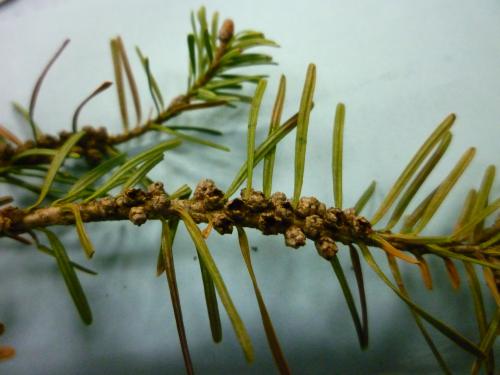Tree, turf and ornamental plant update — May 25, 2018
An update on wet conditions, weeds in turf, eastern tent caterpillar and rusts in conifers.

The following is a summary of current plant development and pest activity for landscape professionals, Master Gardeners, nursery and Christmas tree growers.
Areas in the south portion of Michigan’s Lower Peninsula have had over 8 inches of rain in the past month. Wet turf conditions have delayed mowing and in some cases we are seeing turf yellowing and dying.
Ground ivy (also known as Creeping Charlie), wild violet and several speedwells (Germander and Creeping) are actively flowering in lawns. The flowering period is the best opportunity to kill them until fall arrives. For more information on controlling flowering weeds, read “What to do with the bevy of broadleaf weeds flowering in lawns” from Michigan State University Extension.
Apple scab in crabapples may be a problem due to the lengthy periods of rain this past month, which provided conditions for apple scab spores to develop.
Eastern tent caterpillar tents are visible in tree branches of wild cherry, cultivated Prunus spp., or crabapples,
The orange to yellow spores of Weirs cushion rust, pine-pine gall rust and white pine blister rust are visible on infected needles or branches. For more information on these conifer diseases, see the following MSU Extension articles:
- Bands from Weir’s cushion rust visible on infected spruce needles
- Gall rust found on Scots pines
- White pine blister rust damage showing up
Pollen cones on conifers are relatively small and often go unnoticed. They are usually clustered near the ends of branches and may be yellow, green or purple, but as they dry out they turn brown. Once they have dried out, they can be mistaken for signs of insects or diseases.
Old pollen cones (from previous year). Photo by Jill O’Donnell, MSU Extension.
MSU Diagnostic Services has received several samples of boxwood due to concerns about boxwood blight. Boxwood blight has not been found in Michigan. Damage was found to be due to winter injury, boxwood leafminer, boxwood psyllid and Volutella (Volutella buxi).
Spring rains have provided plenty of standing water for developing mosquito larvae. Recent warm weather should make mosquitos more active.



 Print
Print Email
Email
